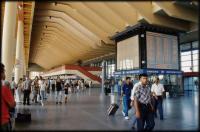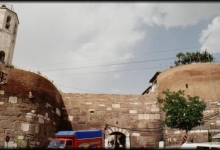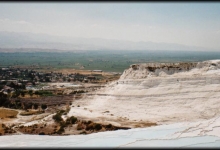We got around using public transportation. This worked well most of time, except when we wanted to get a bit funky in where we were going.Inside the towns, privately-run dolmus (minibus) ferry locals and tourists around. The way these things work is that you look for a bus with your destination written on the front. They do not run on a set schedule, and will stop wherever, whenever to pick people up. Once you get on, clamber to the first available seat. (Our guidebook recommended trying to keep men and women apart, but that never seemed to matter on any of the buses we got on). To find out the price, some minibuses (in tourist areas) will have the prices printed on a sign attached somewhere at the front. Otherwise you just ask. Don’t worry, you’ll be able to afford it. Then, you pass your money to the driver (via the other passengers) and state your destination. You might be asked to pass on money for other people too. Then, somehow, the driver will make change while driving at crazy speeds and looking everywhere for any other passengers. On some dolmus, there will be another guy sitting up front who will help the driver collect fares.
The dolmus system seems pretty chaotic at first, but it works well if you are not in a huge rush to get somewhere for a certain time. And it’s very, very cheap. I believe we always paid local price, no one tried to rip us off because of the cameras strapped around our necks.
The intercity bus system is also pretty intimidating at first, but once you figure it out, it’s pretty manageable. There is no government run system here either – it’s a mess of competing companies at the ‘otogar’ (bus terminal). The otogar is usually located somewhere outside the downtown area with frequent dolmus’ running there. As soon as you step foot in the otogar, you will surely be approached by a “runner” from one of the companies. These runners will try to persuade you that their price is the best, their schedule is the best, etc. Depending on where you are, they can be pretty persistent. Denizli was by far the worst we experienced.If you manage to shake off the runners, congratulations – we never could. They will lead you to their company, where you can find times, prices etc. Then, you have to go window to window if you want to try to find the best time or price. There is no central ticket office that knows all of the bus companies schedules and prices – you have to find them all out yourself, which can get pretty challenging when their English isn’t the best. It took us a while to get used to this system.
Forget booking tickets for other cities in advance – even for different legs of the same trip. If you want to get from A to B with no stops in between and you’re already at point A, you’re in good shape. If you want to book for tomorrow to get from B to C, good luck. Anything complicated can get difficult without speaking Turkish. One thing we never tried was a travel agency, perhaps they could have bought tickets for us.
We tried to stick to the bus companies that were recommended to us (Nevtur, Pamukkale, …). They were all extremely clean, comfortable, and safe. In fact, we never saw any buses that we wouldn’t get on. We didn’t take any night buses, for reasons of security, and also because we wanted to see the scenery.
Bus protocol is pretty strange. There is a ‘steward’ who walks up and down the aisle serving tea, coffee, coke, biscuits, wet towels, and spray-perfume. There are no restrooms on the bus, so they stop every few hours for usually 20 to 30 minutes. However, all of the rest stops we stopped at impeccably clean restrooms – you might have to pay a dime to get in, but these were no American freeway gas station affairs! The women’s usually had a split of squat and normal toilets, by the way. The more reputable companies will give the drivers more breaks.
Another important thing no guide book mentioned about the bus: BE QUIET! And I mean, LIBRARY quiet! We got yelled at a few times for this. The Turks in general are a pretty loud and talkative people, but when they get on a bus, it’s like they’re mourning a funeral. Not a word is spoken – even for a 10 hour daylight bus trip. At one point we struck up a conversation with a Spanish guy on the row beside us. Big mistake. This was before we had figured out the “silence at all times” rule. One of the other passengers on the bus motioned to the steward, they exchanged some words in Turkish, and then the steward came over and told us to please be quiet! What a very odd experience. My wife and I at one point dug out our Travel Scrabble board, to the complete bewilderment of our fellow passengers. An Italian man on a bus we took had his cellphone ring. Half the bus glared at him immediately, and then he answered the call and started a conversation, the steward high-tailed it over to him and pointed frantically to the “no cell phone” sign at the front of the bus.
Be warned that the buses don’t go anywhere that fast. They seem to be pegged to a speed limit of about 89 km/h, and as soon as they go over, the bus beeps menacingly at the driver. Everyone else on the road was doing a pretty decent clip however!
Arrival times were pretty exact, and so were departure times. I have some great video footage of all the buses in one otogar pulling out at precisely 9 am – about 40 of them all at once. It looked like some sort of strange dance. Even the Swiss would be jealous of how on-time these buses are.
The otogars in the larger city are very, very big. These are some of the largest bus stations in the world. We ran into very few foreigners, even though it was peak tourist season. I think almost everybody takes a guided tour – despite how easy it is (and how CHEAP) to travel this country unguided.
Every bus we travelled on was modern, had very comfortable seats, and the temperature was good – not American-shopping-mall cold, but a pleasent temperature, even when it was 110 outside.
Taxis:
We only took one taxi, in Ankara, and it was a good experience. The normal warnings about making sure the meter is on, it’s set for daytime, etc. apply here though.
Trains:
The trains are very slow, from all accounts. We never took one. Buses are simply THE way to get around in Turkey.










“110 outside”? It never gets 110 in Turkey…Maybe a few days in late july in Diyarbakir, around the southeastern point of Turkey.
[Reply]